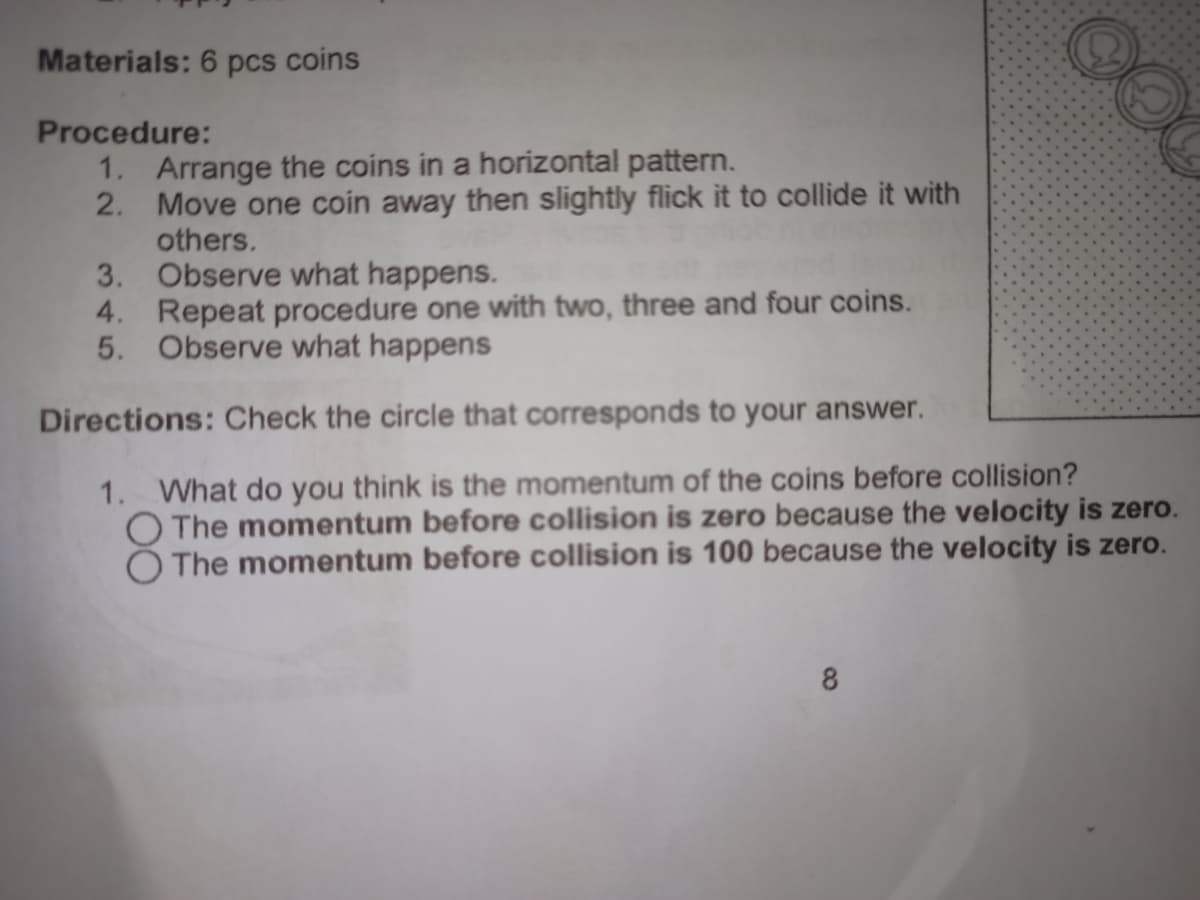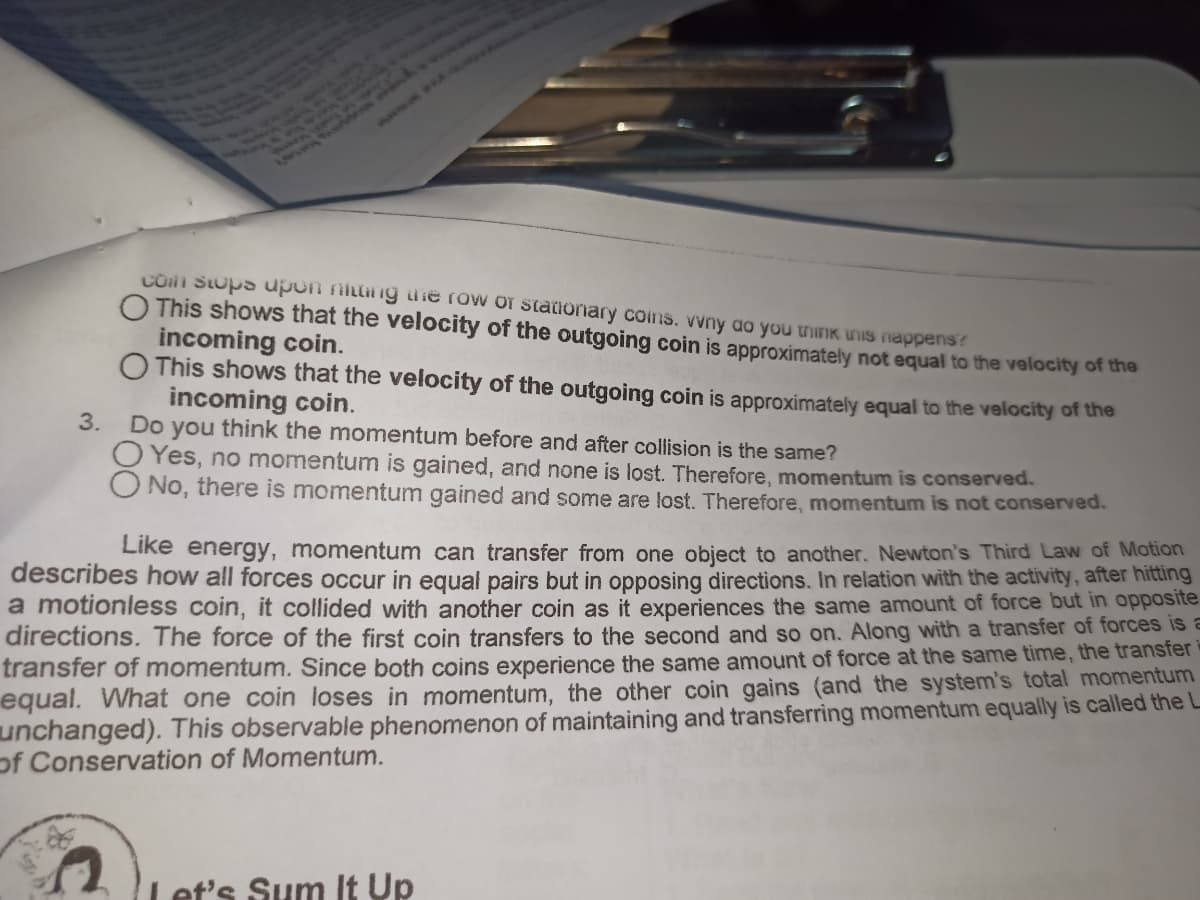Materials: 6 pcs coins Procedure: 1. Arrange the coins in a horizontal pattern. 2. Move one coin away then slightly flick it to collide it with others. 3. Observe what happens. 4. Repeat procedure one with two, three and four coins. 5. Observe what happens Directions: Check the circle that corresponds to your answer. 1. What do you think is the momentum of the coins before collision? O The momentum before collision is zero because the velocity is zero. O The momentum before collision is 100 because the velocity is zero. 8 DO
Materials: 6 pcs coins Procedure: 1. Arrange the coins in a horizontal pattern. 2. Move one coin away then slightly flick it to collide it with others. 3. Observe what happens. 4. Repeat procedure one with two, three and four coins. 5. Observe what happens Directions: Check the circle that corresponds to your answer. 1. What do you think is the momentum of the coins before collision? O The momentum before collision is zero because the velocity is zero. O The momentum before collision is 100 because the velocity is zero. 8 DO
College Physics
11th Edition
ISBN:9781305952300
Author:Raymond A. Serway, Chris Vuille
Publisher:Raymond A. Serway, Chris Vuille
Chapter6: Momentum, Impulse, And Collisions
Section: Chapter Questions
Problem 3CQ: Two carts on an air track have the same mass and speed and are traveling towards each other. If they...
Related questions
Question
1-3 question

Transcribed Image Text:OO
Materials: 6 pcs coins
Procedure:
1. Arrange the coins in a horizontal pattern.
2.
Move one coin away then slightly flick it to collide it with
others.
3.
Observe what happens.
4. Repeat procedure one with two, three and four coins.
5. Observe what happens
Directions: Check the circle that corresponds to your answer.
1. What do you think is the momentum of the coins before collision?
O The momentum before collision is zero because the velocity is zero.
The momentum before collision is 100 because the velocity is zero.
8

Transcribed Image Text:con stops upon nhang the row or stationary coins. vvny do you think this nappens?
O This shows that the velocity of the outgoing coin is approximately not equal to the velocity of the
incoming coin.
O This shows that the velocity of the outgoing coin is approximately equal to the velocity of the
incoming coin.
3.
Do you think the momentum before and after collision is the same?
O Yes, no momentum is gained, and none is lost. Therefore, momentum is conserved.
No, there is momentum gained and some are lost. Therefore, momentum is not conserved.
Like energy, momentum can transfer from one object to another. Newton's Third Law of Motion
describes how all forces occur in equal pairs but in opposing directions. In relation with the activity, after hitting
a motionless coin, it collided with another coin as it experiences the same amount of force but in opposite
directions. The force of the first coin transfers to the second and so on. Along with a transfer of forces is a
transfer of momentum. Since both coins experience the same amount of force at the same time, the transferi
equal. What one coin loses in momentum, the other coin gains (and the system's total momentum
unchanged). This observable phenomenon of maintaining and transferring momentum equally is called the L
of Conservation of Momentum.
et's Sum It Up
Expert Solution
This question has been solved!
Explore an expertly crafted, step-by-step solution for a thorough understanding of key concepts.
Step by step
Solved in 3 steps

Knowledge Booster
Learn more about
Need a deep-dive on the concept behind this application? Look no further. Learn more about this topic, physics and related others by exploring similar questions and additional content below.Recommended textbooks for you

College Physics
Physics
ISBN:
9781305952300
Author:
Raymond A. Serway, Chris Vuille
Publisher:
Cengage Learning

Glencoe Physics: Principles and Problems, Student…
Physics
ISBN:
9780078807213
Author:
Paul W. Zitzewitz
Publisher:
Glencoe/McGraw-Hill


College Physics
Physics
ISBN:
9781305952300
Author:
Raymond A. Serway, Chris Vuille
Publisher:
Cengage Learning

Glencoe Physics: Principles and Problems, Student…
Physics
ISBN:
9780078807213
Author:
Paul W. Zitzewitz
Publisher:
Glencoe/McGraw-Hill
